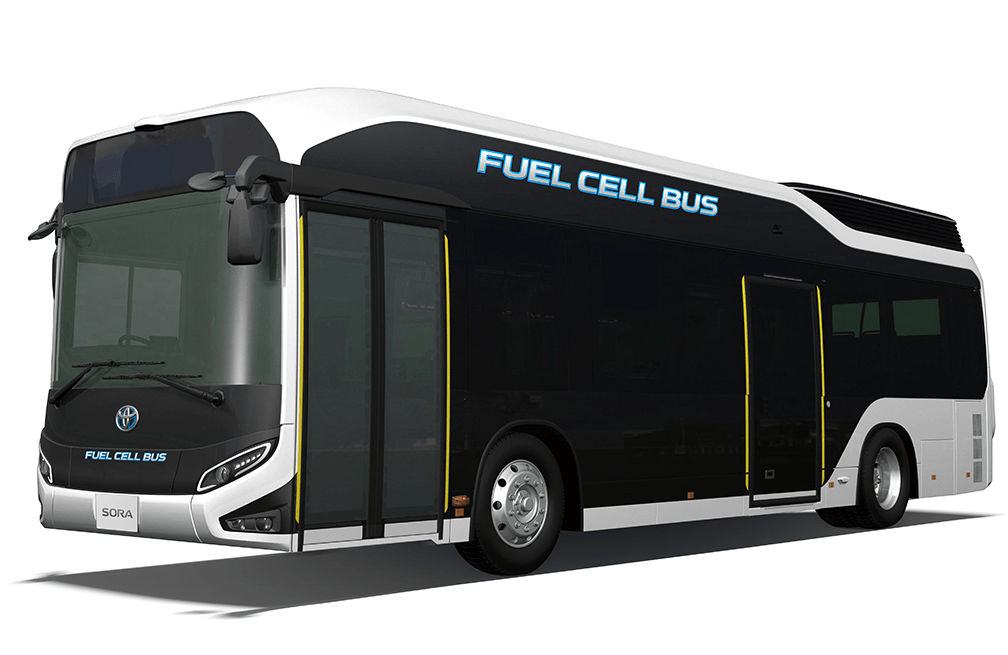Select a province & language
Entrance to this website assumes you have read and agree to these Legal Terms and Conditions and the Privacy Policy.
Entrance to this website assumes you have read and agree to these Legal Terms and Conditions and the Privacy Policy.

So when the Summer Games head to Japan in 2020, visitors will be greeted with Sora, Toyota’s new fleet of eco-friendly buses that can efficiently transport millions of spectators from event to exciting event. Sora buses are powered solely by hydrogen—the universe’s most abundant element—and will generate zero emissions as they move swiftly through the streets of Tokyo.
Sora’s trailblazing technology is evident even before you step on board. The vehicle's futuristic shape, minimal colour palette, and bold LED lighting are a significant departure from the boxiness of conventional transit vehicles. Likewise, the fleet’s very name is a cheeky nod to its innovative design. “Sora” is an acronym taken from the Earth’s water cycle (Sky, Ocean, River, and Air) and the vehicles embody their name as they’re powered by hydrogen and emit water as their sole by-product.
To channel this energy effectively, Sora buses rely on the Toyota Fuel Cell System—a technology that was first developed for the Toyota Mirai hydrogen fuel cell electric vehicle. Each Sora has a high-capacity external power supply system that provides a 9 KW maximum output, and an electricity supply of 235 kWh2. In case of emergency, this system can also be used as an emergency external power source, helping to provide relief and support in times of crisis.
The Sora is about more than just building a better bus—it’s about looking to the future of urban mobility. More than 50 percent of the world’s population currently lives in cities, and this number is predicted to hit 70 percent over the next 40 years. As traffic congestion rapidly intensifies, these new urbanites won’t be able to rely on conventional personal vehicles. Instead, they’ll seek new personal and public transit options that can operate in tandem, and move riders quickly and comfortably through congested areas.
Toyota’s i-Road is a unique, zero-emission vehicle that combines the styling and maneuverability of a motorcycle with the protection and comfort of a small car. Because it has a width of only 870 millimetres, the i-Road overcomes traditional urban obstacles and takes up just one quarter of a conventional parking space. The vehicles have already hit the streets of cities like Tokyo and Paris, and may soon be spotted in North America.
Toyota is also developing a next-generation community network called Ha:mo (Harmonious Mobility Network), to link personal vehicles with public transportation. Under the Ha:mo system, riders can use their smartphones to reserve ultra-compact EV vehicles that are seamlessly incorporated alongside public transportation stations. Real-life testing is now underway in cities in Japan and Thailand.
Sora is slated for production in 2018, and more than 100 vehicles will be deployed in the Tokyo metropolitan area in advance of the 2020 Olympic and Paralympic Games. With millions of passengers riding the fleet, and billions watching from abroad, Sora’s innovative technology could act as a blueprint for a more sustainable future of urban mobility.
Yet the introduction of Sora is just one component of Toyota’s commitment to power the future of urban transportation. By linking people, vehicles and communities through new technology and new concepts, Toyota aims to build a motorized society that’s vastly more eco-friendly, accessible, and enjoyable for all.